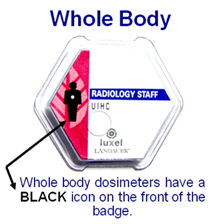Article Published 06/28/17
Each month, the University issues nearly 2000 radiation dosimeters to various staff with potential exposure to ionizing radiation. These dosimeters are worn on the body and record an individual’s monthly radiation dose. In order to get the most accurate (and therefore useful) information from the data collected and listed in dose reports, staff need to keep in mind the following:
Wear your dosimeter(s) in the proper location.
The proper wear for a given dosimeter depends not only on the type of dosimeter, but also on what your potential radiation exposure is.
Whole body dosimeters.
The whole body dosimeter, as shown below, is worn on the trunk of the body (between the head and neck) and beneath protective apparel, such as a lead apron, if one is worn.

Collar Dosimeters

Collar dosimeters, shown above are worn at the collar, typically attached to the outside of a thyroid shield, if one is worn.
Wearing the correct dosimeter in the proper place is critical in obtaining accurate dose results. This is because each dosimeter is weighted differently, based on it’s correct wear position. When dosimeters are worn improperly, or reversed for staff that wear whole body and collar dosimeters, the reported dose can be incorrect by a significant amount.
- When not in use, store dosimeters away from sources of ionizing radiation such as an x-ray procedure room or a radioactive materials storage area. Be careful to avoid wearing them when getting a medical procedure involving radiation exposure as well.
- Return your dosimeters to EHS as soon as you receive your new dosimeters. Timely dose information is very important, especially if there is an unusual reading; determining the cause of a suspicious reading is easier when less time has elapsed.
If you have any questions about your dosimeter, dosimeter service, or results, please contact Joey Michael at (319)335-8518.